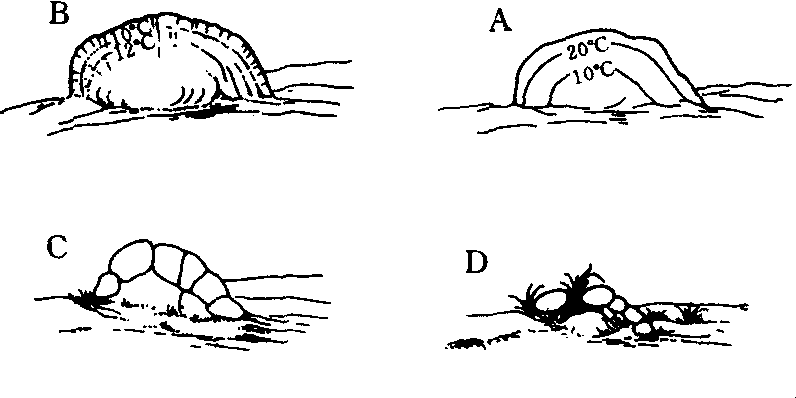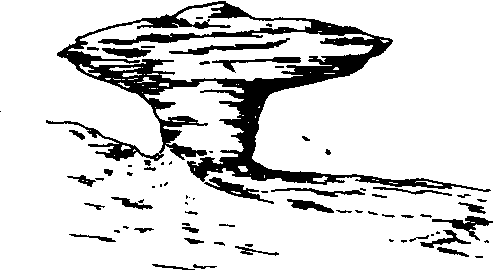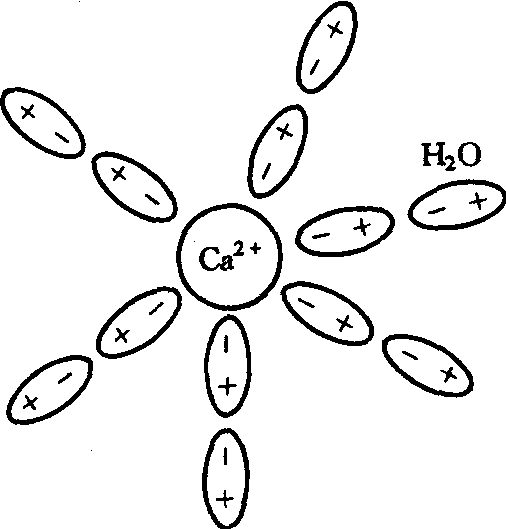风化作用fenghua zuoyong
裸露或接近地表的岩石和矿物经物理、化学、生物等作用逐渐疏松、崩解或改变化学成分,变成大小不等的岩屑和土层,这种现象称为风化作用。根据风化作用的性质不同,可分为物理风化、化学风化和生物风化三种类型: ❶物理风化: 指岩石受到温度变化和冻融作用而产生的机械崩解,基本上不改变其化学成分,而只改变个体大小的作用。例如,岩石在太阳照射作用下,因其比热小,白天岩石表层很快增温产生热力膨胀,但岩石又是热的不良导体,内部增温很慢,因而在岩石表层与内部之间产生因热应力引起的膨胀变形量不同;夜间相反,表层散热快,体积急剧收缩,内部散热慢仍大体保持原来体积,两者之间不同步进行着。如此长期表里不均一地膨胀与收缩,表层就产生垂直和平行于岩石表面的两组断裂,天长日久,岩石表面发生层状剥落以至崩解破碎。如果岩石裂隙或孔隙充填着水,在气候寒冷而结冰时,因体积膨胀对岩石裂隙两壁产生巨大压力,使之裂隙扩大加深;当气温升高时,冰水融化,水沿扩大的裂隙向更深处渗入,如此反复进行,致使岩石逐渐崩裂成岩屑。在干旱地区,岩石中的盐类重结晶时,对岩石产生撑胀作用,亦可导致岩石的破碎。
❷化学风化: 指岩石在水、大气、生物的相互作用下发生氧化、溶解、水解和水化等一系列化学反应,因而改变了岩石的物理性质和化学成分,甚至形成新的矿物,破坏了原来岩石的结构,使岩石成为松散的土层,这种作用称为化学风化作用。溶解是指水对矿物的直接溶解,进行速度虽慢,但由于水的渗入可增加岩石孔隙,利于物理风化进行;其次,是指含有CO2的水,对碳酸盐类进行溶解,成为碳酸氢钙,在水循环强烈的石灰岩地区,形成各种喀斯特地貌。水解是指矿物与水发生反应而分解的过程,例如正长石水解变成高岭土,其结果不仅使矿物硬度降低,而且因体积膨胀,产生巨大压力,使岩石崩解。水化作用是指水与一些不含水的矿物相化合,水参与到矿物的晶格中,改变了原来的矿物分子结构,形成新的矿物,如硬石膏经水化作用形成石膏,其结果硬度变小,密度降低,并引起体积膨胀,从而加速岩石的崩解。
❸生物风化:指岩石受到生物的活动所产生的机械风化和化学溶解作用。如植物根系的生长楔入到岩石裂隙中产生生物物理挤胀作用,使岩石裂隙不断扩展以至破碎,故又称根劈作用。生物在新陈代谢过程中,分泌各种有机酸,对岩石进行化学溶蚀,也能使岩石遭到破坏。总之,上述三种作用相互制约同时进行,对岩石起着破坏的作用,但在不同环境地区所起的主、次作用不同。此外,人类活动如开矿、采石以及酸雨的污染等对岩石及建筑物的破坏也在逐渐加强,应引起人们的关注。风化作用是形成地球表面土壤层的基本阶段,也是促使地貌形成与发育的先导条件。
风化作用weathering
地壳最表层的岩石在空气、水、温度和生物活动的影响下,发生机械破碎和化学变化的过程。其实质是在高温高压条件下形成的矿物和岩石暴露在地表后,在地表减压、降温和其他环境条件的影响引起在物质组成上重新调整的变化过程。这些变化大都是放热反应,从高能量状态转变为低能量状态。
风化作用类型 包括物理风化、化学风化和生物风化3种。
物理风化 岩石在地表条件下以崩解方式机械地岩石破碎成细块和微粒的作用,但并不改变它的化学组成。岩石发生物理风化的主要因素有三:
温度因素 岩石是热的不良导体,由线胀和体胀系数不同的多种矿物组成。在昼夜、寒暑温度剧变的影响下,地表的岩石产生不均一的胀缩,逐渐使整体的岩石碎裂崩散。由于各种矿物的颜色、热容量不同,它们传热的速率及升温程度各异;地表与深层的岩石受气温影响程度也不相同,愈近地面,其冷热变化愈为频繁而激烈。所有这些都促使地壳最表层的岩石与其主体分离,在地表的某些岩石露头,还可产生层状剥离的球状风化现象(图1)。物理崩解初始时使岩石产生了裂纹,这些裂纹又为水、空气、生物的进入而进一步风化。

图1 因温度变化引起岩石胀缩不均而呈球状崩解过程示意图
A.白天在太阳照射下,岩石表层迅速增温时形成的温差; B.夜间降温,岩石表层迅速冷却时形成的逆温温差; C—D.天长日久,岩石因发生风化裂隙而崩解
冰冻作用 温度变化使岩石表层产生裂隙,降水就可渗入而保存于裂隙中。当温度降到冰点以下,岩隙中的水冻结成冰,其体积增加9.2%; 对裂隙壁面造成的压力可高达600千克/厘米2,导致岩石破碎。
流水、冰川和风的影响 地表流水常携带泥沙、碎石不断移动而使之遭受磨蚀割切; 它既可使其颗粒磨圆,也可使之进一步碎裂。这是一种最重要和最广

图2 由风蚀作用形成的蘑菇石
化学风化 岩石在外部因素作用下,其组成矿物的化学成分发生分解和改变,直至形成在地表环境中稳定的新矿物的作用。与化学风化有关的反应主要有

图3 离子水合层模式
水合作用 指水分子与矿物晶格离子结合的作用,由岩浆中结晶出来的原生矿物是在没有液态水的条件下形成的,当这些矿物露出地表就与液态水接触。各种矿物也是由带正电荷的不同离子晶格构成的,位于表层的离子具有未饱和的电荷引力,当水分子偶极体与带有电荷的另一物体相遇时,就以偶极体的一端与矿物晶格上带有相反电荷的离子相吸引,围绕这些离子形成一个水膜(水合层)(图3),这样,矿物就发生了水合作用,如硬石膏水合后成为结晶石膏,赤铁矿水合后成为水赤铁矿。

水偶极体也对矿物离子发生吸引作用,力图把离子从晶格上拉下来,矿物受水分子偶极体引力和矿物晶格在地表减压状态的作用,使矿物晶格松散而破坏。矿物经水合作用后,硬度降低,体积增大,溶解度增加,从而促进其它化学风化作用的发展。
水解作用 水分子通常有很小一部分是以解离状态H+、OH-存在的,当水与矿物晶格接触,其氢离子就能置换位于矿物晶格中的阳离子,如各种盐基离子(K+、Na+、Ca2+、Mg2+等),而进入晶格中占据原来阳离子的位置,其中OH-则能置换矿物晶格中的阴离子(如SiO4-4、S2-、Cl-、F-等)。例如,水与正长石晶格作用时,其H+可置换正长石的K+,使K+进入溶液与溶液中OH-形成KOH,呈碱性反应,余下的成分分解为硅酸和高岭石,产生脱硅作用。
4KAlSi3O8+14H2O→Al4 (Si4O10) (OH) 3+8H2SiO3+4KOH
溶液中的钾和硅酸可以保持在溶液中,也可受降水淋洗而排除,产生脱盐基和脱硅作用; 或为生物吸收利用而形成生物体。气候越湿润,对盐基、硅酸等成分的淋洗作用越强,越能促进矿物的分解,温度是影响水解作用的活泼因素,如果以0℃时水的解离度为1,则10℃时增为1.7,34℃为4.5,50℃时为8.0,可见随着温度增高,水的解离度和水解作用亦相应增强,故热带、亚热带湿润地区矿物化学分解强烈,风化壳深厚。水解作用可能是地壳表层矿物化学分解的最为广泛的形式。
碳酸化作用 大气中含有0.03%体积的CO2;在25℃和1大气压下,溶入水中的CO2浓度为0.0339mol/L,溶液的pH为3.92,其H+浓度比纯水约大1 000倍,这就大大加强了它的化学分解作用。尽管碳酸是一种弱酸,因在大气、水和土壤中广泛存在,它是促使岩石、矿物分解极重要的因素。
>氧化作用 大部分岩浆岩、变质岩和部分沉积岩都是在缺氧条件下形成的,这些岩石中的矿物所含变价元素如铁、锰、硫等都以低价状态存在,这些矿物一旦暴露于地表,其内部的低价离子与含氧的水接触时,就会被氧化成高价离子,如橄榄石中的铁(Fe2+)被氧化成Fe3+后,矿物晶格的电价平衡就遭到破坏,矿物就逐渐分解。这种风化作用对富含变价元素的岩石、矿物(如富含亚铁的橄榄石、角闪石、辉石,含黑云母的基性岩石)尤为强烈。
3MgFeSiO4+3HCO→H4Mg3Si2O9+H2SiO3+3FeO
橄榄石 蛇纹石 硅酸 氧化亚铁
4FeO+O2→2Fe2O3
溶解作用 水对各种矿物都有一定的溶解力,即使不溶解的石英晶体(SiO2)在常温时的水中的溶解度也达到5mg/kg。溶有CO2和其他酸类的水,其溶解力更大,在含碳酸的水作用下,巨大的石灰岩山地经长期溶解淋失可以夷为平地和巨大的地下溶洞,其化学反应如下:
CaCO3+H2O+CO2=Ca(HCO3)2
溶解作用的重要意义更在于它与矿物的各种化学风化密切结合,使其反应物在溶解过程中产生淋移或发生新的合成作用,促进原生矿物的水解作用、氧化作用和矿物质元素的大规模移动。据Reade的研究资料估计,全地球每年每平方千米被溶解移走的物质平均为37吨,其中包括19.3吨碳酸钙,7.7吨硫酸钙,3.1吨氯化钠,2.7吨硅酸(SiO3),2.3吨碱金属碳酸盐和硫酸盐,1.5吨碳酸镁和0.39吨氧化铁。在降水量813mm的英格兰淋洗深度达到465mm的条件下,每年每平方千米溶失成分可达55.4吨。生物风化作用 指生物的生命活动和死亡后的残体分解物对岩石、矿物的分解作用,植物庞大根系在岩石和矿物裂隙中生长时产生的机械压力使岩石崩解,穴居动物在地下拨土、挖洞对岩石矿物的机械破坏都属于生物物理风化作用;而生物呼吸放出的CO2,分泌的有机酸和有机残体腐解后产生的大量有机酸和盐类,都积极参与矿物的化学风化作用。硅藻能分解铝硅酸盐,利用硅酸形成它的甲壳,同时分离出游离的氢氧化铝。生物体产生的一些有机酸还可与矿物中的一些金属离子(如Fe3+、Al3+、Mn2+等)络合,促进这些惰性元素从反应系统中移走,加速矿物的风化。
可见,岩石风化是上列多种风化作用共同作用的结果,它们是相互联系和相互影响的,在特定的环境中,常以某些风化作用为主:如干旱寒冷地区,生物活动微弱,以机械破碎的物理风化为主;在温暖湿润地区,生物活动旺盛,则化学风化和生物风化居主导地位,而物理风化就显得不强烈,但它可以促进生物化学风化作用的进行。
矿物风化序列 是矿物按其对风化作用的稳定性或易风化性排列的次序。它可用来了解一个土壤的“风化程度”,衡量土壤中保存的原有养分状况和理化性质;估计土壤的发育途径及其经历的环境条件。显然,了解土壤的风化情况不论在认识土壤发生发育和肥力等方面都是具有重要意义的。
戈尔迪奇(S.S.Goldich,1938)从土壤大粒级和小粒级二方面来研究矿物风化稳定性的。对土壤大颗粒级(砂和粉粒)中原生矿物的抗风化能力大小排成序列,称作矿物风化的稳定性序列(图4)。

图4 砂粒和粉粒级矿物颗粒的风化序列(S.S.戈尔迪奇)
这个序列说明,最不稳定的矿物是那些在最高温度的熔融岩浆中结晶的矿物;矿物结晶条件越接近现在地球表面环境条件,则在地表风化环境中的稳定性就越高。矿物抗风化能力的不同,一方面与矿物结晶离子的本身性质有关,同时亦决定于矿物的晶格结构。例如,占岩浆岩总体92%的主要造岩矿物长石、角闪石、辉石、橄榄石、云母、石英等硅酸盐矿物来说,其结晶构造的基本单位是硅氧四面体和金属原子构成的电中性体;不同的硅酸盐矿物只是由于硅氧四面体彼此联结方式及所含金属原子不同而已。石英矿物(SiO2)的全部氧原子都是与硅原子以共价键的强力联结形式紧密结合的,它没有离子键,故抗风化能力最强,在土壤形成过程中,许多矿物都被风化消失,而石英却仍能保留下来。橄榄石(Mg,FeSiO4)的氧原子除与硅原子以共价键强力联结外,还与镁、铁原子以较弱的离子键进行联结。离子键是容易受水化、水解、氧化、溶解等作用而分解,加上铁原子的变价特征,因此容易被氧化,抗风化能力小,辉石、角闪石、长石、云母的氧原子与硅原子的共价键联结多于橄榄石,而少于石英,故其抗风化力介乎二者之间,硅酸盐矿物的氧硅比率和共价键数的多少引起的结晶构造的差别,与实际观察到的矿物风化稳定性是一致的(表1)。
表1 硅氧四面体的排列方式与代表性矿物
| 单体的 | 单链的 | 双链的 | 层状的 | 三向的 |
| 橄榄石 | 辉石族 普通辉石 | 闪石族 普通角闪石 | 黑云母 (云母族) | 石英 |
| →矿物风化稳定性增强→ | ||||
| 氧—硅比率 | ||||
| 4 | 3 | 2.7 | 2.5 | 2 |
杰克逊和舍曼(M.L.Jackson,G.D.Sherman,1953)研究了土壤粘粒级的主要原生矿物和次生矿物的抗风化能力,建立起代表性矿物风化阶段的概念,以反映土壤矿物组成和风化强度的关系(表2)。
粘土矿物的形成和转化 矿物在风化作用中进行
表2 代表性矿物风化阶段及其相应的土壤类型
| 风化阶段 | 代表性矿物 | 典型土壤类型及特征 | |
| 早 期 | 1 | 石膏(包括岩盐、硝酸钠) | 在细粉粒和粘粒级中,以这些矿物为 主的幼年土遍布世界各地,主要为漠区 土壤; 该地区受水分限制,化学风化作 用极为微弱,故易溶盐可保存于土壤中; 石膏、方解石、橄榄石等易风化矿物保持 稳定而不被风化 |
| 2 | 方解石(包括白云石、磷灰石) | ||
| 3 | 橄榄石、角闪石(包括辉石) | ||
| 4 | 黑云母(包括海绿石、囊脱石) | ||
| 5 | 钠长石(包括钙长石、微斜长 石、正长石) | ||
| 中 期 | 6 | 石英(包括方英石) | 在细粉粒和粘粒级中,以这些矿物为 主的土壤主要发育在温带草原和森林 下,如黑土、黑钙土、棕壤、褐土(相当于 软土、淋溶土、始成土)等,石英在这些土 壤中经常很多,可代表第6阶段,伊利 石,蛭石,蒙皂石是随土壤中长石、云母 的风化蚀变而后重新合成增多起来的, 它们都存在于粘粒级中 |
| 7 | 白云母(包括绢云母、伊利石) | ||
| 8 | 2:1型层状硅酸盐矿物(包括 蛭石,膨胀的水化云母 | ||
| 9 | 蒙皂石 | ||
| 晚 期 | 10 | 高岭石(包括埃洛石、水铝英 石) | 湿热区高风化,强淋溶土壤,包括砖红 壤、红壤(或氧化土、老成土)。细土部分 的原生矿物,除石英等抗风化矿物外,全 部或大部被风化消失。 土壤养分元素贫 乏,只赖生物循环补给 |
| 11 | 水铝矿(包括勃姆石) | ||
| 12 | 赤铁矿(还有针铁矿、褐铁矿) | ||
| 13 | 锐钛矿(还有金红石、锆英石) | ||
风化作用所处的环境、土壤的离子浓度及其平衡反应、pH值条件等对形成某种次生粘土矿物起着决定性作用。云母类矿物的晶格结构与它风化蚀变后的次生粘土矿物有类同的层状晶格结构,在一定的风化环境条件下,它可以直接蚀变转化为相应的粘土矿物,由图5可见,云母⇌伊利石⇌蛭石⇌蒙皂石⇌高岭石⇌铁、铝氢氧化物由左向右的过程是风化程度的加深;脱硅作用、脱盐基作用加强,矿物的结构和成分越趋简单;由右向左是新生矿物的合成过程,它的条件是复硅作用和复盐基作用。例如按照基特里克(Kittrick)多年的平衡试验,在硅酸浓度较高时,高岭石可以复硅化成为蒙脱石,这二种矿物共生在96mg/kgSiO2的溶液里,高于这个界限,可由高岭石合成蒙脱石;低于这个界限时,蒙脱石就转变为高岭石。
三水铝石和高岭石共生在1.3mg/kgSiO2溶液里,当高于这个SiO2浓度界限,三水铝石合成为高岭石;低于这个界限,则高岭石转化为三水铝石。
对于长石类及橄榄石、角闪石、辉石等铁镁矿物,由于它们是架状链状晶格结构,就需要在风化作用中先蚀变为简单的晶架,重新组合成层状结构,才能形成各种次生粘土矿物,究竟形成哪一种粘土矿物,则同样取决于溶液中的成分、pH—Eh值及离子平衡反应的条件。火山灰,火山玻璃是在原子未及组成晶格之前固结起来的非晶质矿物,在湿润条件下,

图5 矿物风化形成土壤次生粘土矿物的可能途径
次生矿物的转化和合成的途径是错综复杂的,下列各种土壤粘土矿物的转化和重新组合的条件已经研究证明。❶伊利石,常见于风化作用不很强烈的温带地区土壤中,具较小的酸度,可使钾从云母晶层中部分的消除,溶液中有中等或较高浓度的硅酸和铝离子存在,以保持其稳定。
❷蛭石,在硅酸和铝离子相对浓度较高和存在于较酸性的条件下,伊利石中的钾完全被移走,就形成蛭石。
❸蒙皂石,在碱性到微酸性条件下,淋溶较弱,风化层(或土层)中能维持相当高的硅酸和镁离子浓度时,就有利于伊利石、蛭石形成蒙皂石。
❹高岭石,在长期的酸性淋溶条件下,溶液中缺钾,缺镁,缺乏其他盐基,硅酸和铝离子浓度大致相等时,就有利于伊利石、蒙皂石等风化程度弱的矿物转化为高岭石。反之,当硅酸、钾、镁离子浓度较高,呈微酸性淋溶时,高岭石可重新合成为蒙皂石或伊利石。
❺铁铝氧化物,在温带地区,土壤中的高岭石是稳定的,不会被分解,如果在热带湿润地区土壤溶液中的硅酸和盐基俱已淋失的条件下,高岭石进一步彻底分解,产生的硅酸继续受淋洗,残留下溶解度低的氢氧化铝凝胶,逐渐浓缩为水铝矿积累下来。在氧化环境条件下,由含铁矿物分解出来的铁离子则以含水氢氧化铁胶状物沉淀出来,最后浓缩为褐铁矿、针铁矿、赤铁矿。在潜水还原条件下,铁矿物不稳定,易转化为可溶的亚铁而淋失。
土壤风化度和淋溶度指标 在地表化学风化作用下,岩石和土壤中的矿物受到不断的分解而蚀变为简单的产物,在分解中释放出的盐基及硅酸,在水的淋溶作用中被大量排走,只有难溶的次生硅酸盐类粘粒和铁铝氧化物积累下来。化学风化越深刻,淋洗越强烈,则矿物的分解越彻底,盐基和硅酸的淋失越多,铁铝氧化物的相对积累也就越多。因此,可以用风化体或土体中盐基、硅酸和二三氧化物三者间的分子比率来估测土壤的风化度和淋溶度。
硅铝率 Sa值(马伯特,C.F.Marbut),即Ki值(哈拉索韦兹,H.Harrassowitz),指土壤粘粒所含SiO2量与所含Al2O3量的分子数的比率,用SiO2/Al2O3或Sa表示。
 Sa值越小,说明土壤粘粒中SiO2含量越低,即在风化过程中硅酸盐的分解越强,淋失越多,氧化铝的残余积累越显著,土壤风化度高,砖红壤、红壤(相当于氧化土纲、老成土纲土壤)等富铝化土壤具有这一特征。反之,如果Sa值大,说明土壤粘粒部分的SiO2含量高,硅酸盐矿物的分解不强,Al2O3的残余积累少,土壤的风化度小; 例如,黑钙土、栗钙土、褐土等土壤具有这一特征。
Sa值越小,说明土壤粘粒中SiO2含量越低,即在风化过程中硅酸盐的分解越强,淋失越多,氧化铝的残余积累越显著,土壤风化度高,砖红壤、红壤(相当于氧化土纲、老成土纲土壤)等富铝化土壤具有这一特征。反之,如果Sa值大,说明土壤粘粒部分的SiO2含量高,硅酸盐矿物的分解不强,Al2O3的残余积累少,土壤的风化度小; 例如,黑钙土、栗钙土、褐土等土壤具有这一特征。硅铁铝率 Saf值,指土壤粘粒中所含SiO2量与所含Al2O3、Fe2O3总量的分子比率,用SiO2/R2O3或Saf表示。
 在土壤排水良好的好气条件下,铁处于氧化状态,与氧化铝的性状相同,都是不被淋溶而积累下来的,当土壤排水差,具还原嫌气条件时,则土壤中高价铁将被还原为可溶性亚铁而淋走,所以R2O3就不像Al2O3那样准确地代表土壤风化过程中的残余积累量。在反映土壤风化度时,都用Sa值,而不用Saf值。
在土壤排水良好的好气条件下,铁处于氧化状态,与氧化铝的性状相同,都是不被淋溶而积累下来的,当土壤排水差,具还原嫌气条件时,则土壤中高价铁将被还原为可溶性亚铁而淋走,所以R2O3就不像Al2O3那样准确地代表土壤风化过程中的残余积累量。在反映土壤风化度时,都用Sa值,而不用Saf值。土壤风化度 即μ值

由于土壤粘粒对钾的选择吸附性大于钠,故K/Na比值始终大于1,土壤风化过程和淋溶作用越强,Na的淋失较之K的损失相对地亦越大,土壤的μ值(即土壤风化度)也就越大,据H.詹尼(Hans Jen-ny,1948)统计,黑钙土的μ值平均为1.066,灰化土为1.516,红黄色灰化土为2.767,砖红壤性土为3.206,μ值由温带湿润、半湿润区土壤向冷湿及湿热区土壤增大。
土壤风化淋溶系数 (H.哈拉索韦兹),即ba值,指土壤中的氧化钾、氧化钠和氧化钙分子数之和与氧化铝的分子数的比率,即

K+、Na+、Ca2+、Mg2+等盐基离子在风化过程中是易遭淋洗的成分; 氧化铝是土壤风化物的惰性成分,因而是最主要的残余积累成分。因此,土壤的ba值大,说明在风化过程中盐基离子保存多,淋洗少,即风化淋溶度小; 反之,如土壤ba值小,说明土壤风化中盐基离子保存越少,风化淋溶度强。风化度弱者,包括温带干旱、半干旱区的土壤,如棕钙土、栗钙土、黑钙土、褐土、棕壤等;风化度强者,包括湿热地区或冷湿地区针叶林下的土壤,如砖红壤、红壤、黄壤、灰壤等。詹尼还提出ba1值
 和ba2值
和ba2值 等指标,其涵义与ba值基本上相同,同样可反映一个土壤的风化淋溶度。
等指标,其涵义与ba值基本上相同,同样可反映一个土壤的风化淋溶度。土壤的淋溶指数或淋溶因子 即β值,詹尼根据土壤化学全量分析资料,认为一个土壤淋溶层的ba1
 与母质层的ba1值比率可以用来说明土壤风化淋溶程度的强弱,β值越小,说明土壤淋溶层的盐基淋溶系数比母质层的淋溶系数大,土壤处于强淋溶过程;反之,β值越大,说明土壤淋溶层与母质层盐基淋溶系数相近,亦即土壤风化淋溶度越弱。另一指标称为βⅡ,即淋溶层的ba2
与母质层的ba1值比率可以用来说明土壤风化淋溶程度的强弱,β值越小,说明土壤淋溶层的盐基淋溶系数比母质层的淋溶系数大,土壤处于强淋溶过程;反之,β值越大,说明土壤淋溶层与母质层盐基淋溶系数相近,亦即土壤风化淋溶度越弱。另一指标称为βⅡ,即淋溶层的ba2 与母质层ba2的分子比,它与β值一样可说明土壤风化淋溶的强度。
与母质层ba2的分子比,它与β值一样可说明土壤风化淋溶的强度。
风化作用Fenghuo zuoyong
通过物理、化学、生物等作用,使地表或接近地表的岩石、矿物逐渐崩解、疏松或改变化学成分,变成岩屑和砂土,这种现象叫风化,这种作用称为风化作用。岩石受到温度变化、冻融作用和其它机械作用力的影响,产生崩解、破碎,改变块体大小,而基本上不改变其化学成分的现象称为物理风化。例如,白天在太阳光线照射下,岩石表面很快被晒热,而其内部随深度增加,增温渐小。在夜晚情况刚好相反,岩石表面很快散热冷却,而其内部冷却较慢,这就造成了岩石表里的冷热不均,收缩和膨胀的不协调,日久天长便会发生裂纹和裂隙,这就是坚硬岩石崩解的开始。顺着岩石裂隙进入雨水,冬季寒冷使水结冰,体积膨胀,扩大岩石裂隙,随之泥沙、矿物质充填缝隙。在干旱季节,缝隙中的盐类重新结晶,也会产生很强的撑胀作用。这些物理的或机械的破坏作用都会使岩石崩解破碎。
岩石在水、一水溶液和空气中的氧与二氧化碳等的作用下,发生溶解、水化、水解、碳酸化和氧化等一系列复杂的化学变化,这种引起岩石成分和性质的变化叫化学风化。它使岩石中可溶的矿物逐步被溶蚀、流失或渗透到风化壳下层,重新沉积。残留原地的或新形成的多为难溶的稳定矿物。化学风化的结果使原岩中的缝隙加大,孔隙加密,破坏了原岩的结构和成分,甚至使坚硬的岩层变成松散的土层。岩石在生物活动的影响下所产生的机械破坏和化学变化称为生物风化。如生长在岩石裂隙中的植物,由于其根系逐渐加粗、增长,使岩石裂隙受到像楔子一样劈裂作用,不断地使岩石裂缝扩大加深。植物根系在岩石缝中一般可深达几十厘米到1米左右,甚至可达十几米,对周围岩石可产生10—15公斤/厘米2的压力。一些小动物的挖掘和穿凿活动也会加速岩石的破碎。生活在岩隙和土壤中的动物和植物,在新陈代谢过程中不断分泌出各种化合物,如碳酸、硝酸和各种有机酸等,对岩石起着强烈的溶蚀和破坏作用。特别是一些微生物的活动,作用非常明显,它们有的可以吸收空气中的氮制造硝酸,有的能吸收CO2制造碳酸,有的能吸收硫制造硫酸。这些酸类对岩石起到很强的腐蚀作用。事实上物理风化、化学风化和生物风化三者是紧密相联的。物理风化使岩石的孔隙度增大,使岩石具有较好的渗透性,有利于水分、空气、微生物和植物根系的深入。当岩石崩解为较小的颗粒,使其表面积增大,更有利于化学风化作用的进行。所以物理风化是化学风化的前驱和必要条件,而化学风化又是物理风化的继续和深入。三者紧密相联、同时进行、互相影响、互相促进。
影响风化的因素很多,主要因素是:❶气候因素:在不同的气候带,风化作用有明显的差异性。在极地和高山带,温度很低,地面大部被冰雪覆盖,冻融作用盛行,化学风化缓慢,长期处于物理风化为主的阶段。在干旱荒漠地带,日照很强,年降水量小于250毫米,蒸发量大于降水量,热力风化盛行,化学风化微弱,也是长期处在物理风化为主的阶段。在半干旱草原地带,日照强,年降水量250—500毫米,蒸发量也大于降水量,热力风化仍较强,但氯化物和硫酸盐等大部分被淋溶,而钙、镁、盐类相对富集,并在土层中上下移动,常形成钙积层,所以化学风化长期停留在富钙阶段。在半湿润森林草原地带,年降水量500—750毫米,蒸发量与降水量相近,化学风化长期处于富钙和富硅铝两阶段之间,常形成蒙脱石次生粘土矿物。在温湿地带,年降水量750—1 000毫米,降水量大于蒸发量,化学风化长期处于富硅铝阶段,主要形成水云母次生粘土矿物。在湿热地带,年降水量大于1 000毫米,气温高,植物茂盛,细菌活跃,岩石矿物风化迅速,风化壳很厚,最厚可达200米以上,常形成一些大型的铁、锰、铝风化矿床。
❷地形因素:不同地形条件下,风化的强度、深度和风化物的厚度及分布状况不同。在地形高差很大的山区,一般风化的深度和强度大于平缓的地区,但在斜坡上岩石破碎后很易被剥落、冲刷而移离原地,所以风化层一般都较薄,颗粒较粗,粘粒很少。在平原或低缓的丘陵地区,地表水和地下水流动都比较慢,风化物易被保存下来,在平缓低凹的地区风化壳一般都很厚。地形的起伏和切割程度,直接影响地下水的流动、埋藏深度和流动状态,一般在沟谷切割剧烈的地方,有利于风化作用的进行,但在不同地貌部位上风化物的类型及分布厚度差异很大。
❸地质因素:岩石的矿物组成、结构和构造都直接影响风化的速度、深度和风化阶段。在同一环境下,由于不同岩石类型或同种岩石不同部位风化程度的差异,会造成许多特殊的微地貌形态。岩石抵抗风化的能力,主要是由组成岩石的矿物成分决定的。在物理风化过程中,深色矿物比浅色矿物易风化。基性岩类多含深色矿物,而酸性岩类多含浅色矿物,因此,在野外常可见到基性岩墙被风化成浅沟状,而在石英岩层出露的地方常形成突脊形态。从岩石的结构上看,粗粒的岩石比细粒的易风化,多种矿物组成的岩石比单矿物岩石易风化,粒度相差较大的和有斑晶结构的岩石比粒度均匀的岩石易风化。从构造上看,断裂破碎带的裂隙、节理、层理、页理等部位是比较软弱的地方,容易遭到风化。如花岗岩是由颜色深浅不同或颗粒大小不均的矿物组成的,这是它容易风化的内在原因。同时它具有三组相互正交的原生节理,把岩体分割成许多大小不等的近似正方形或长方形的岩块,这样在风化过程中,三组节理交会的棱角部位最易风化,使棱角逐渐圆缓而成为球形石块,这种现象称为球状风化(图1)。在球状风化迅速发展的情况下,岩块逐渐变小减少,并被大量风化泥沙所包围。当这些风化物质遭受流水冲蚀,并将细粒泥沙和小块碎石带走,使残留的球状岩块堆迭在一起,往往形成一堆一堆的圆球状花岗岩堆。偶尔有个别的大型石球停留在岩坡坎上,处于暂时平衡状态,摇摇欲坠,甚至人推就能摇摆,故称摇摆石(图2)。由于花岗岩的这种特性,在风化过程中还经常形成一些奇特的地貌形态,如图3苏州焦山之石桌,形如一丛蘑菇。花岗岩形成的山峰往往是线条流畅、形态浑圆、峰峦峻秀,如著名的黄山风景区就是由花岗岩构成的基岩山地。

图1 球状风化

图2 福建东山岛的摇摆石

图3 苏州焦山之石桌(花岗岩球状风化)
风化作用Fenghuazuoyong
地表或接近地表的岩石,在温度变化、水及水溶液的作用、大气及生物作用等的影响下发生的破坏作用。风化作用可分为三种类型:物理风化作用、化学风化作用和生物风化作用。❶物理风化作用:由于温度变化以及由此而产生的水的冻结、解冻作用引起的岩石机械破碎,而没有显著的化学成分变化的作用。日夜和季节温度变化可使岩石发生膨胀和收缩。岩石表里受热不均,膨胀、收缩不等,使岩石表面发生裂隙,裂隙不断加深扩大使岩石表面松动、破碎、剥落。岩石是由一种或多种矿物组成,不同矿物吸热和反射光的能力不同、膨胀系数不同,由于温度的变化,矿物颗粒的膨胀和收缩不一致,天长日久也会导致岩石表面的崩解破碎。在季节变化显著的高寒地带,由于气温变化可在一日或一年之内发生冻结和解冻现象。岩石裂隙中的水分遇冷结冰,体积增大,使岩石裂隙扩大;气温增高,冰融成水,继续向裂隙深处渗透。这样一冻一解反复进行,就像冰楔一样把岩石劈开崩碎,称为冰劈作用。
❷化学风化作用:岩石在水、氧气、二氧化碳等作用下发生的化学分解作用。岩石经过化学风化作用,不仅原来的成分发生改变,而且会产生新的矿物。岩石在氧化作用下,使其中低价元素转变为高价元素,低价化合物转变为高价化合物,如橄榄石、辉石、角闪石、黑云母等,经氧化作用其中的低价铁变为高价铁,颜色由黑变为褐红,原来的矿物成分被分解破坏了。水在自然界中是普遍存在的,几乎所有的化学作用都是在水溶液中进行的。水能直接参加到矿物中去,使某些矿物变为新的含水化合物,如硬石膏(CaSO4)变成石膏(CaSO4·2H2O)其体积增大30%,可使其周围的岩石发生破坏。矿物中的K+、Na+、Ca2+、Mg2+等阳离子很容易被水中的OH-所夺取,这样使矿物原来的结构发生变化并被分解破坏。自然界中很少有纯水,水中常含有各酸类,可加速对岩石的破坏作用,特别是含有碳酸的水对于岩石的破坏作用就更为普遍,如水中含有CO2对石灰岩的溶蚀能力增加十几倍到几十倍。各种岩石在化学风化作用下,逐渐遭到分解破坏,一方面形成高岭石、氧化铁等不溶物质,残留原地,另一方面形成一些可溶物质或胶体溶液随水淋失搬运到别处。
❸生物风化作用:生物活动对岩石产生的破坏作用。生物可以引起岩石的机械破坏,如植物根系可以深入到岩石裂缝中生长,能产生10—15公斤/厘米2的压力,是可劈开岩石;穴居地下的蚯蚓、鼠类等经常翻松土层加速岩石风化;生活在岩石表面的细菌、蓝绿藻、苔藓、地衣等,经常分泌有机酸,分解岩石。上述的物理、化学、生物三种风化作用实际上并不是孤立进行的,而是相互联系、相互影响的统一过程,只是在某种自然地理条件下经常以某中风化作用占主导地位,而其它风化作用降为次要地位。
风化作用
太阳辐射、水、气体和生物等在大气条件下得以使地壳岩石的物理性状和化学成分发生变化的作用。
风化作用weathering
地球表层的矿物和岩石由于温度变化、水、大气以及生物的作用发生崩裂、分解而形成碎屑和新矿物的过程。风化使矿物、岩石适应地表低温低压和富水富氧的环境,达到在地表热力条件下的平衡和稳定。岩石经风化作用变成松散碎屑,即成土母质,具有通气透水性,释放出植物能吸收的营养元素,产生初步的土壤肥力性质,是进一步形成土壤的物质基础。因此,风化作用是成土作用的基础。可分为物理风化、化学风化和生物风化,一般情况下它们是同时同地进行的。